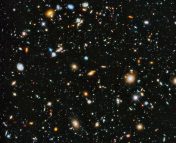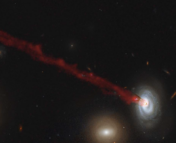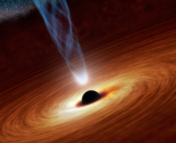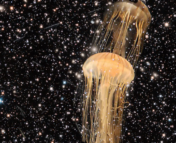
I’m David O’Ryan, a third year PhD student in the observational astrophysics group at Lancaster University, UK. The focus of my research is exploring and understanding interacting and merging galaxies and the impact they have on galaxy evolution and formation. When not working on research, I spend a lot of time reading science fiction in coffee shops, writing articles or short stories and running extra programming projects.
Title: Shadows in the Dark: Low-Surface-Brightness Galaxies Discovered in the Dark Energy Survey
Authors: D. Tanoglidis, A. Drlica-Wagner, K. Wei, T. S. Li, J. Sanchez, Y. Zhang, A. H. G. Peter et al. (Dark Energy Survey Collaboration)
First Author’s Institution: University of Chicago, Chicago, USA
Status: Published in the Astrophysical Journal (ApJ) (open access)
Entering the Dark: The Low Surface Brightness Regime
How we see the universe is dictated by the detection limitations of our telescopes. When considering this we can’t only use a galaxy’s total brightness (measured by its magnitude). To see the whole galaxy we must account for the brightness over the entire extended object, and how that brightness changes. This is given by a galaxy’s average surface brightness, a measurement accounting for the brightness of all its parts. Take the example of the Andromeda galaxy, which is a very bright galaxy in the sky: having an apparent magnitude of 3.44. Measuring the brightness across it, including the dim regions such as parts of the spiral arms and the scattered stars in its halo, the average surface brightness (or depth) becomes a surprisingly low 22.3 mags/arcsec2.
The limiting depth of our telescopes sits at a value of 28.6 mags/arcsec2. Achieving this is only really possible with the DragonFly Telephoto Array (even then, with extremely careful image analysis). But what if a galaxy is so faint that it’s at a depth of 29.0 mag / arcsec2? Or even 28.6 mags / arcsec2 but observed by a different instrument? We wouldn’t detect them at all! Galaxies (or any object) that are at this depth are in what is known as the low surface brightness (LSB) regime: a new frontier in astronomy.
So, what are we missing? This is the question today’s authors are trying to answer. They are searching for low surface brightness galaxies (LSBGs) at the very limits of what our telescopes are capable of detecting. It turns out when you really look hard at this region, we are missing a lot. In fact, it is possible that LSBGs account for 15% of mass in the present day universe!
Finding the Light in the Dark: The Dark Energy Survey and Machine Learning
To shed light on this dim regime, our authors use the Dark Energy Survey (DES). This survey is perfect to look for LSBGs. It covers an eighth of the sky, recorded information of over 300 million galaxies and (after careful image analysis) was able to reach a depth of 28.26 mag / arcsec2. Most importantly, it was designed to find galaxies which are often very faint and relatively small (sounds familiar). The authors comb the data with machine learning algorithms and a group of experts double check the algorithm’s results, aiming to extract anything that may be an LSBG.
In total, they found 23,790 LSBGs at their maximum depth! By far, the largest catalogue of LSBGs to date. So, with such a catalogue, what can we learn about LSBGs?

How the Shadows Fall: LSBG Characteristics
One might expect that LSBGs are just galaxies with oddly few stars, very far away or obscured. It turns out this is only sometimes true. Some are so dim because they are ultra-diffuse, a galaxy that covers a big area with not too many stars.
Besides these ultra-diffuse galaxies, the authors find that the catalogue is dominated by regular galaxies. In their LSBG sample they find there are two very distinct populations: a red one and a blue one. Figure 1 shows this split in colour. This bi-modality is incredibly important. A galaxy’s colour is related to how much star formation is occurring. If a galaxy is blue it means there is a lot and if a galaxy is red star formation has long since stopped.
So, if there’s still lots of starforming and non-starforming galaxies here, why are they so dim? The answer may lie in the spatial distribution of the catalogue in the DES field. The resultant distribution of the blue galaxies and red galaxies is shown on the left and right of Figure 2, respectively.
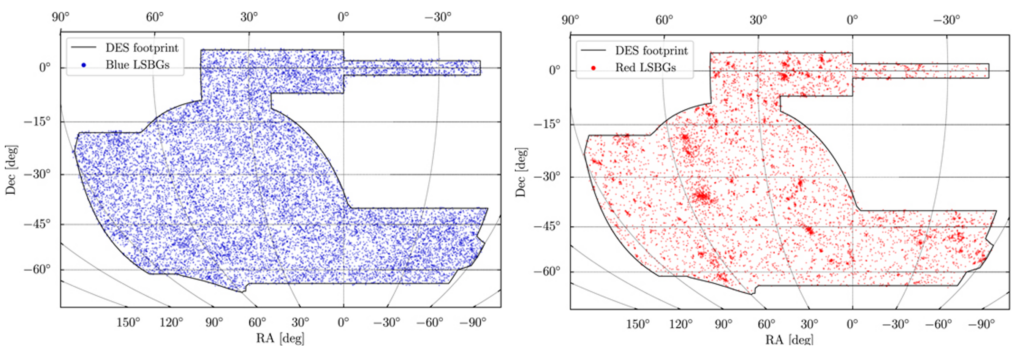
The blue LSBGs are almost equally distributed throughout the DES observational footprint, but the clustering of red LSBGs is unmistakable. The authors find that the red LSBGs exist in or around galaxy clusters. Here, the intracluster environment (the gas/material between the galaxies) strips them of their gas by interaction or ram-pressure stripping: draining them of their ability to form stars. Before long, they are red and dead. The blue LSBGs are primarily highly irregular galaxies existing in isolation, and show signs of spiral structure and are brighter (on average) than their red counterparts. So, they may be the same objects but in different galactic environments!
A Brighter Tomorrow: The Vera C. Rubin Observatory
The presented catalogue of 23,790 LSBGs is just the beginning of our exploration of this new frontier in astronomy. By looking at the very limits of our instruments, we have only just been able to split galaxies in the LSB regime to blue and red galaxies. With the construction of the upcoming Vera C. Rubin observatory (due to be completed in late 2023) any previous record of depth will be smashed, with it reaching a depth of 27.8 mag / arcsec2 before any analysis is needed. Then, the entire LSB regime will come to light.
Astrobite edited by: Mark Popinchalk

